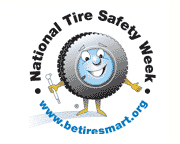National Tire Safety Week Tire Safety Tips
 |
Greenville, SC--June 3, 2014: National Tire Safety Week is an industry-wide initiative that educates drivers about the importance of proper tire care. Summer is the season for road trips, so now is a good time to brush up on your tire maintenance knowledge. Remember though, tire safety is critical all year round.
According to experts from Michelin and TireRack.com, all you need to remember is T-I-R-E. Tread
Tire tread and traction are linked. The grooves in your tires are there to help channel water away. For example, this is one of Michelin’s newest tires, Premier® A/S tire with EverGrip™, which has grooves that expand with wear, as well as added grooves that emerge over time – both of which help improve the tire's grip in wet weather.
You can use a coin like a quarter to check your tread depth. If you can see the very top of George Washington’s head when the coin is inserted into the tread, you have less than 4/32” of tread remaining. In most states 2/32” is the legal minimum. Make sure you turn the wheel so you can see the whole tire. The tread could be worn on the inside. If you just look at the side, you might not catch a trouble spot.
Inflation
Tire inflation, or pressure, influences safety and fuel economy, so pressure should be checked at a minimum both once a month and before trips to ensure you refill lost pressure and discover any leaks.
The optimal tire pressure for your car can be found on a sticker in the door jamb, on the inside of the glove compartment door or in the owner's manual. Do not inflate tires to the maximum pressure molded onto the tire's sidewall. Adjust for extra loads. Whether towing a boat or simply loading up with passengers and luggage, you may need to increase your tire pressure to accommodate the additional weight of the load. Refer to your owner’s manual for alternate recommended pressures. The pressure cannot be accurately estimated through visual inspection, so it is best checked with a quality gauge. Check tires “cold” for the most accurate reading. This means in the morning before you drive more than a few miles or before the sun's heat can affect them. Even spare tires lose pressure over time. Putting underinflated spare tires into service greatly increases the risk of catastrophic failure. Check your spare tire’s pressure monthly with the rest of the set. For a list of quality air gauges or to learn more about the dangers of underinflated tires, visit www.tirerack.com.
Rotation
Regular rotation helps extend the life of your tires, saving time and money in the long run. Tires should be rotated every 6,000 to 8,000 miles. Education
Unfortunately, tire safety is not often taught in drivers’ ed classes, which is why Tire Rack continues to support Tire Rack Street Survival -- a national driver education program aimed at teaching teens the skills they need to stay alive behind the wheel. With the months between Memorial Day and Labor Day being the 100 Deadliest Days for teens, it’s more important now than ever for adults, teens and all driver’s sharing the road to be prepared.
Celebrating 12 years of saving the lives of young drivers nationwide, one community at a time, Tire Rack Street Survival’s continued focus is to teach students the basics and beyond of car control, to enhance their enjoyment of driving and to improve their competence as drivers. The goal is for students to understand how their actions govern a car’s responses, what their vehicle’s limitations are, and as a result to become safer, more effective drivers on the road by learning how to avoid accidents entirely.
You can see the schedule or request to be notified about upcoming schools in your area by visiting StreetSurvival.
We hope you take the time to share these tips with a driver you care about.


